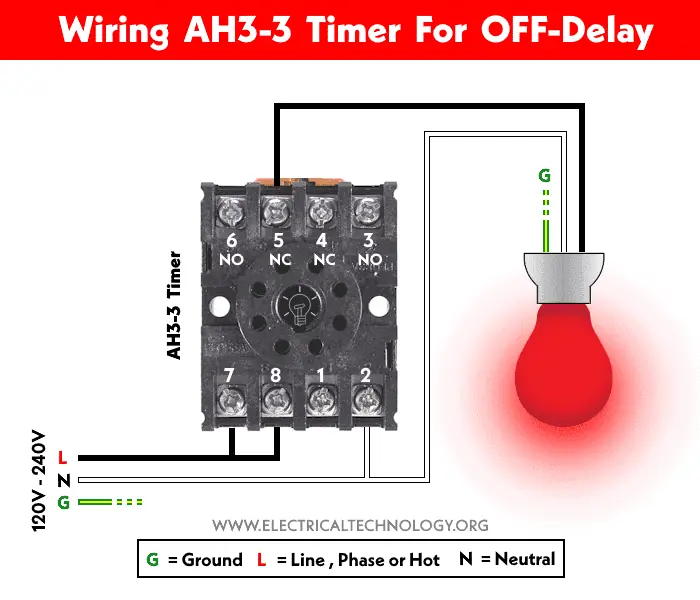Giriş
Gecikmeli ve gecikmesiz zamanlayıcılar, kontrol sistemlerinde çok önemli bileşenlerdir ve her biri giriş sinyallerine göre zamanlama davranışlarına bağlı olarak farklı işlevlere hizmet eder. Açık gecikme zamanlayıcıları çıkışı etkinleştirmeden önce bir gecikme sunarken, kapalı gecikme zamanlayıcıları giriş sinyali kaldırıldıktan sonra çıkışı belirli bir süre boyunca korur ve çeşitli endüstriyel ve otomasyon uygulamaları için benzersiz avantajlar sunar.
Temel Bilgi
ON Gecikme Zamanlayıcısının Tanımı ve Çalışma Prensibi
Açık gecikme zamanlayıcısı olarak da bilinen AÇIK gecikme zamanlayıcısı, bir giriş sinyalinin etkinleştirilmesi ile ardından bir çıkış sinyalinin etkinleştirilmesi arasında bir duraklama sağlar. Tetiklendiğinde, zamanlayıcı önceden ayarlanmış bir süreden itibaren bir geri sayım başlatır ve bu süre boyunca çıkış devre dışı kalır. Yalnızca önceden belirlenmiş bu süre geçtikten sonra çıkış sinyali etkinleşir, bu da onu kontrollü bir başlatma sırası gerektiren uygulamalar için ideal hale getirir.
OFF Gecikme Zamanlayıcısının Tanımı ve Çalışma Prensibi
Bir KAPALI gecikme zamanlayıcısı, giriş sinyali kaldırıldıktan sonra çıkış sinyalini belirli bir süre boyunca korur. Etkinleştirildiğinde, hemen çıkışı tetikler ve girişin devre dışı bırakılmasını takiben önceden ayarlanmış gecikme süresi boyunca aktif kalır. Bu işlevsellik, ilk tetikleme kaldırıldıktan sonra kontrollü bir kapatma veya uzun süreli çalışma gerektiren uygulamalarda özellikle kullanışlıdır. Yaygın kullanım alanları şunlardır:
Detaylı Karşılaştırma
AÇIK Gecikme Zamanlayıcısı ile KAPALI Gecikme Zamanlayıcısı Arasındaki Farklar
| Özellik | AÇIK Gecikme Zamanlayıcısı | KAPALI Gecikme Zamanlayıcısı |
|---|---|---|
| Aktivasyon | Giriş sinyalinden sonra etkinleştirmeyi geciktirir | Giriş sinyali üzerine hemen etkinleşir |
| Devre dışı bırakma | Gecikmeden sonra çıkışı etkinleştirir | Girişten sonra bir gecikme için çıkışı korur |
| Tipik Kullanım Örnekleri | Motorları veya sistemleri kurulumdan sonra çalıştırma | Kapatmadan önce fanların soğumasına izin verme |
Avantajlar ve Dezavantajlar
- AÇIK Gecikme Zamanlayıcısı
- Avantajlar: Proseslerin ne zaman başlayacağı üzerinde hassas kontrol sağlar; erken aktivasyonu önler.
- Dezavantajlar: Uygun şekilde ayarlanmadığı takdirde kritik operasyonlarda istenmeyen gecikmelere yol açabilir.
- KAPALI Gecikme Zamanlayıcısı
- Avantajlar: Süreçlerin kapanmadan önce tamamlanmasını sağlar; soğutma sistemleri için kullanışlıdır.
- Dezavantajlar: Dikkatli bir şekilde yönetilmezse çalışma sürelerinin uzamasına neden olabilir.
Uygulama Senaryolarının Karşılaştırılması
- AÇIK Gecikme Zamanlayıcıları aşağıdaki gibi uygulamalarda yaygın olarak kullanılır:
- Ekipmanın hemen çalışmaması gereken HVAC sistemleri.
- Hareket başlamadan önce öğelerin yerleşmesine izin verilmesi gereken konveyör bantları.
- OFF Gecikme Zamanlayıcıları şu alanlarda uygulama bulur:
- Bir odadan çıktıktan sonra kısa bir süre açık kalması gereken aydınlatma sistemleri.
- Tamamen kapanmadan önce soğuması gereken motorlar.
Zamanlama Fonksiyonlarındaki Farklılıklar
Açık gecikme ve kapalı gecikme zamanlayıcıları arasındaki temel ayrım, zamanlama işlevlerinde yatmaktadır. Gecikmeli zamanlayıcılar (TON), giriş sinyalinin etkinleştirilmesi ile çıkış sinyali arasında bir gecikme yaratır ve etkinleştirmeden önce çıkışı önceden belirlenmiş bir süre boyunca devre dışı tutar. Bu davranış, sistem şoklarını önlemek veya kararlılığı sağlamak için kademeli aktivasyon gerektiren uygulamalar için kullanışlıdır. Tersine, kapalı gecikme zamanlayıcıları (TOF) giriş sinyalini aldıktan hemen sonra çıkışlarını etkinleştirir, ancak giriş sinyali kapatıldıktan sonra bu çıkışı belirli bir süre boyunca korur. Bu özellik özellikle ekipmanın devre dışı bırakıldıktan sonra kısa bir süre daha çalışmaya devam etmesi gereken senaryolarda, örneğin makinelerin çalışma sonrası soğutulması gibi, faydalıdır.
Çıkış Sinyali Davranışı
Açık gecikme ve kapalı gecikme zamanlayıcılarının çıkış sinyali davranışı önemli ölçüde farklılık gösterir. Açık gecikme zamanlayıcıları için çıkış, gecikme süresi boyunca etkin olmaz ve yalnızca ayarlanan süre geçtikten sonra etkinleşir. Örneğin, 10 saniyelik bir ayarda çıkış, giriş etkinleştirildikten 10 saniye sonra enerjilenecektir. Bunun aksine, kapalı gecikme zamanlayıcıları giriş sinyali alındığında çıkışlarını hemen etkinleştirir. Giriş kaldırıldığında, çıkış kapanmadan önce belirtilen gecikme boyunca aktif kalır. Bu davranış, giriş sinyali kesildikten sonra çalışmaya devam edilmesini sağlar, bu da kapalı gecikme zamanlayıcılarını güç kaybından sonra acil durum ışıklarını açık tutmak veya makinenin kapanmasından sonra soğutma fanlarının çalışmasına izin vermek gibi uygulamalar için ideal hale getirir.
Pratik Uygulamalar
Endüstriyel Kontrolde Uygulama Örnekleri
Endüstriyel ortamlarda, ON ve OFF gecikme zamanlayıcıları kontrol devrelerinin ayrılmaz bileşenleridir. Örneğin:
- Tüm güvenlik kontrolleri tamamlanana kadar bir motorun çalışmamasını sağlamak için bir AÇIK gecikme zamanlayıcısı kullanılabilir.
- Bir montaj hattında, üretim durduktan sonra makinelerin kısa bir süre çalışmasını sağlamak ve malzemenin temizlenmesine izin vermek için bir KAPALI gecikme zamanlayıcısı kullanılabilir.
PLC Programlamada Uygulama Örnekleri
Programlanabilir Mantık Denetleyicilerinde (PLC'ler) bu zamanlayıcılar fonksiyon blokları olarak uygulanır:
- AÇIK gecikme fonksiyon bloğu, yalnızca belirli koşullar karşılandıktan sonra işlemleri başlatmak üzere programlanabilir.
- KAPALI gecikme fonksiyon bloğu, çıkışları işlem tamamlandıktan sonra ek bir süre daha aktif tutmak için ayarlanabilir.
Farklı Sektörlerdeki Spesifik Uygulama Örnekleri
Çeşitli endüstriler bu zamanlayıcıları kullanmaktadır:
- Üretim: Zamanlamanın kritik olduğu sıralı işlemler için.
- HVAC: Ekipman başlatma ve kapatma işlemlerini etkin bir şekilde yönetmek için.
- Gıda İşleme: Makinelerin yalnızca güvenli koşullar sağlandığında çalışmasını sağlamak.
Zamanlayıcıların Sembolleri ve Kablolama Yöntemleri
Zamanlayıcılar şemalarda belirli sembollerle temsil edilir. Kablolama yöntemleri, elektromekanik veya katı hal cihazları olmalarına göre değişir ve düzgün işlevsellik için net bağlantılar gerekir.
AÇIK Gecikmeli Tel Yöntemi
KAPALI Gecikmeli Tel Yöntemi
Kredi için elektrikteknolojisi
Zamanlayıcılarda Sorun Giderme ve Bakım
Düzenli bakım, bağlantıların kontrol edilmesini, ayarların doğru olduğundan emin olunmasını ve arızalı bileşenlerin değiştirilmesini içerir. Sorun giderme, multimetrelerle test etmeyi veya kontrollü koşullar altında çalışma davranışını gözlemlemeyi içerebilir.
Doğru Zamanlayıcıyı Seçme
Açma gecikmesi ve kapama gecikmesi zamanlayıcıları arasında seçim yaparken, özel uygulama gereksinimlerini ve istenen çalışma davranışını göz önünde bulundurun. Anahtar faktörler şunları içerir:
- Zamanlama ihtiyaçları: Açık gecikme zamanlayıcıları aktivasyondan önce istenen bekleme süresine göre ayarlanırken, kapalı gecikme zamanlayıcıları giriş kesildikten sonra devam eden çalışma süresi için yapılandırılır.
- Yük özellikleri: Farklı yükler, güvenli ve verimli çalışma için özel zamanlama stratejileri gerektirebilir.
- Kontrol devresi tasarımı: Kablolama konfigürasyonları ve PLC programlama dilleri ile uyumluluğu sağlayın.
- Çevresel koşullar: Gerilim, akım ve koruma seviyelerini göz önünde bulundurarak çalışma ortamı için derecelendirilmiş zamanlayıcıları seçin.
- Kullanıcı ayarlanabilirliği: Kolay gecikme ayarı için kullanıcı dostu arayüzlere sahip zamanlayıcıları arayın.
SSS
Bir Kapalı Gecikme Rölesi Ne Zaman Zaman Gecikmesi Sağlar?
Kapalı gecikmeli bir zaman rölesi, zaman geciktirme işlevini özellikle giriş gerilimi veya kontrol sinyali kaldırıldığında sağlar. Etkinleştirmeyi geciktiren on-delay zamanlayıcıların aksine, off-delay röleler zamanlama sırasını devre dışı bırakma anında başlatır. Bu benzersiz özellik, onları bir sistem kapatma işlemi başlatıldıktan sonra çalışmaya devam etmeyi gerektiren uygulamalar için ideal hale getirir.
- Gecikme, giriş gücü kesildiğinde veya kontrol anahtarı açıldığında hemen başlar
- Çıkış, önceden ayarlanmış gecikme süresi boyunca enerjili kalır ve bağlı cihazların çalışmaya devam etmesine izin verir
- Gecikme süresi geçtikten sonra rölenin kontakları durum değiştirir, tipik olarak devre bağlantısını kesmek için açılır
- Gecikme süresi boyunca giriş voltajı yeniden uygulanırsa, çoğu gecikme dışı zamanlayıcı sıfırlanarak zamanlama sırasını yeniden başlatır
Bu zamanlama davranışı, kademeli veya gecikmeli devre dışı bırakmanın güvenlik veya operasyonel verimlilik için çok önemli olduğu motor soğutma, acil durum aydınlatması ve kontrollü kapatma işlemleri gibi senaryolarda özellikle yararlıdır.
Zaman geciktirme rölesi nasıl çalışır?
Zaman geciktirme röleleri, elektrik kontaklarının zamanlamasını kontrol ederek, belirli bir tetikleme olayından sonra açılmalarını veya kapanmalarını geciktirerek çalışır. Bu cihazlar özünde dahili bir zamanlama mekanizması ve röle kontaklarından oluşur. Etkinleştirildiğinde, zamanlama mekanizması nanosaniyeden birkaç dakikaya kadar değişebilen önceden programlanmış bir gecikme süresine dayalı bir geri sayım başlatır.Süreç tipik olarak şunları içerir:
- Bir giriş sinyali alma (elektriksel veya mekanik)
- Dahili zamanlama mekanizmasının etkinleştirilmesi
- Önceden ayarlanmış gecikme süresini geri sayma
- Gecikme sona erdiğinde röle kontaklarının durumunu değiştirme (açma veya kapama)
Zaman gecikmeli röleler, açık gecikme (bir sinyal aldıktan sonra etkinleştirmeyi geciktirme) veya kapalı gecikme (sinyal kaldırıldıktan sonra bir süre etkinleştirmeyi sürdürme) gibi çeşitli işlevler için yapılandırılabilir. Bu çok yönlülük, hassas zamanlama ve güvenilirliğin çok önemli olduğu motor kontrolü, aydınlatma sistemleri, endüstriyel otomasyon ve güvenlik sistemleri dahil olmak üzere çok sayıda uygulamada kullanılmalarına olanak tanır.
Daha fazlasını keşfedin: Zaman Gecikmeli Röle için Tam Kılavuz
Sonuç
Bu makale, ON gecikme ve OFF gecikme zamanlayıcılarının temel yönlerini araştırmış, tanımlarını, çalışma prensiplerini, avantajlarını, dezavantajlarını ve çeşitli endüstrilerdeki pratik uygulamalarını vurgulamıştır. Teknoloji ilerledikçe, bu zamanlayıcılar operasyonel verimliliği ve güvenliği artırmada önemli bir rol oynamaya devam edecektir. Bu konuyu daha fazla araştırmak isteyen okuyucular, daha derin bilgiler için belirli üretici kılavuzlarını veya gelişmiş otomasyon ders kitaplarını incelemeyi düşünebilirler.
Daha fazlasını keşfedin:




